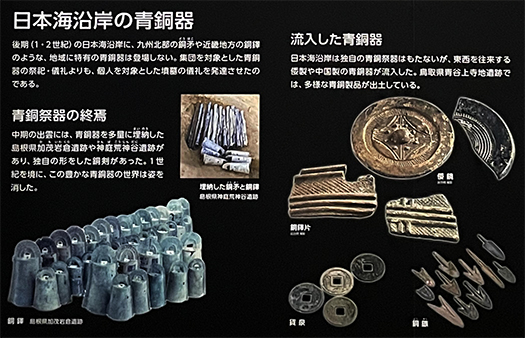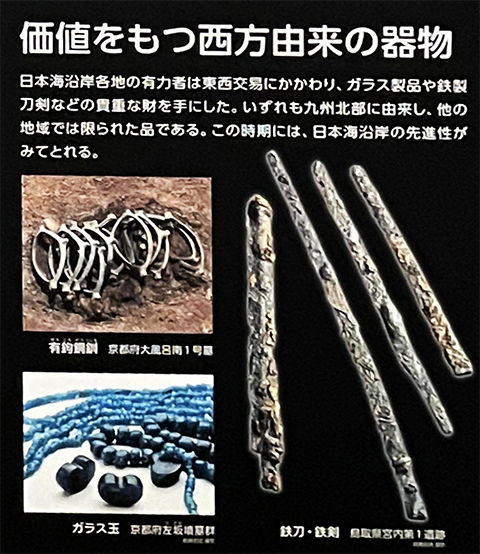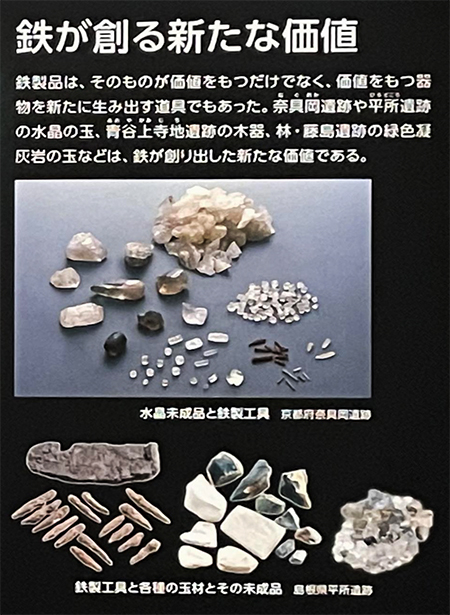

九州北部は日本列島のなかでは大陸・半島の文化流入の入口。
とはいえ、列島社会全体からすれば西のはずれに属する。
水田農耕がどんどんと東進していくことでその「適地」で人口増加が起こり
列島社会の中では多様な地域社会が形成されていった。
日本海側地域というのはそのなかでも有力な地域だったことで、
独自の地方勢力が力を持った存在になっていった。
「特徴ある墳墓と王」という国立歴史民俗博物館パネル説明では以下の記述。
〜島根東部・鳥取西部を中心に四隅が張り出した形の墳墓が広がり
北陸にも及んだ。京都・兵庫北部では丘陵を利用した方形の墳墓を築造。
やがて共有の墓の中から大型の墳丘と特殊な副葬品をもつ有力者が登場する。〜
そして「日本海沿岸の青銅器」パネル説明は以下。
〜後期(1-2世紀)日本海地域に北部九州の銅矛や近畿地方の銅鐸のような
地域特有の青銅器は登場しない。集団を対象とした青銅器の祭祀・儀礼より
個人を対象とした墳墓の儀礼を発達させた。〜
そして「青銅記紀の終焉」では
〜中期出雲には青銅器を多量に埋納した荒神谷遺跡などがあり、独自の形をした
銅剣があった。1世紀を境にこの豊かな青銅器の世界は姿を消した。〜
やはり「出雲王権」の状況が見て取れるように思える。
日本海側を東進した人口増加がひとつの集団意思に統合されていた、
そういった仮説は十分に成立するように思われる。
それらの勢力が年に1月ほど神無月に出雲に集まって集会を開き、
独自の連合的「国家」を形作っていたものが出雲王権の実質と想像できる。


「価値を持つ西方由来の器物」では〜日本海側沿岸の有力者は東西交易に関わり
ガラス製品や鉄製刀剣などの貴重な財を入手した。いずれも北部九州に由来し
他地域では限られていた財。この時期の日本海沿岸の先進性がみてとれる。〜
さらに「鉄が創る新たな価値」では〜鉄製品はそのものが持つ価値だけではなく
価値を持つあらたな器物を生み出す道具。水晶の玉、木器、緑色凝灰岩の玉、
などは鉄が創り出したあらたな物質価値だった。〜
列島社会での人口増加に伴って各地域に有力者が生まれて
それらの間で交易・交流が広がることで次第に「統一王権」という志向が
当然のように沸き立っていったことが容易に想像できる。
神武の一統は九州北部から瀬戸内海地域を進み、
岡山の吉備地域の有力層と強い同盟もしくは連携を得て
勇躍、大阪湾・難波地域に上陸を図ろうとしたと考えられる。
そういう東征が成功を収めて畿内地域に王権が樹立されたことで
出雲は「国譲り」して従ったという流れが自然だと思われますね。
このことは列島の支配構造・祭祀構造として環日本海型から
大和中心の集権型が勝利したという史実を表現しているのでしょうか。
English version⬇
The Izumo Kingdom: The Sea of Japan in the 1st and 2nd Centuries, 37,000 Years of Japanese Archipelago History-42
The eastward expansion of rice cultivation and agriculture created large population centers in various regions, starting in northern Kyushu. The Izumo Royalty Union was established in these areas. The Izumo Royalty Union was established in these areas.
Northern Kyushu is the gateway to the influx of continental and peninsular cultures in the Japanese archipelago.
Nevertheless, it belongs to the western edge of the archipelago’s society as a whole.
As paddy field agriculture moved eastward, the population grew in the “suitable” areas, and diverse local communities were formed within the archipelago society.
This led to the formation of various regional societies in the archipelago.
The Sea of Japan region was one of the most influential regions in the archipelago.
The Sea of Japan region was one of the most powerful regions in the archipelago, and its own local power became a powerful entity.
The National Museum of Japanese History’s panel “Characteristic Tombs and Kings” explains the following
〜The tombs with overhanging four corners spread mainly in eastern Shimane and western Tottori.
They also extended to the Hokuriku region. In Kyoto and northern Hyogo, square tombs were built on hillsides.
Eventually, among the shared tombs, influential figures with large burial mounds and special burial accessories appeared. ~.
And the “Bronze Artifacts from the Sea of Japan Coast” panel description is below.
〜In the late 2nd century, no region-specific bronze artifacts such as bronze pikes from northern Kyushu and bronze bells from the Kinki region appeared in the Sea of Japan region.
Bronze artifacts unique to the region do not appear in the Sea of Japan region. Bronze rituals and ceremonies are more important than group rituals and ceremonies.
The development of individual tomb rituals was more important than group rituals. ~.
And in “The End of the Bronze Chronicle
〜In the mid-1st century, Izumo had a large number of bronze artifacts buried at the Aragamitani site, including a uniquely shaped bronze sword.
After the 1st century, this rich world of bronze disappeared. ~.
The situation of the “Izumo Kingdom” can still be seen.
The population growth that moved eastward along the Sea of Japan was consolidated into a single collective will.
Such a hypothesis seems to be quite plausible.
These forces gathered in Izumo about one month a year during the kaminashi month, held a meeting, and formed their own federated “nation”.
The Izumo Kingdom was in fact a unique federated “nation.
In the “valuable vessels of western origin,” the leading figures of the coastal areas along the Sea of Japan were involved in trade between the east and west, and obtained valuable goods such as glassware and iron swords.
obtained valuable goods such as glassware and iron swords. All of them originated from northern Kyushu.
goods that were limited in other regions. The advanced nature of the Japan Sea coast during this period can be seen. 〜The “Iron and Steel” section of this report is a good example of this.
Furthermore, in “New Value Created by Iron,” the author explains that iron products not only have value in their own right, but also
Iron products were not only valuable in their own right, but they were also tools for creating new vessels with value. Crystal balls, wooden vessels, green tuff balls
were new material values created by iron. 〜The first time iron was used in the world was in the 1930s.
As the population of the archipelago grew, powerful people emerged in each region.
As trade and exchange expanded among them, the desire for a “united kingdom” gradually
It is easy to imagine that the desire for a “unified kingship” gradually rose as a natural result of the expansion of trade and exchange among them.
The Jinmu line advanced from northern Kyushu to the Seto Inland Sea region.
The Jinmu line advanced from northern Kyushu to the Seto Inland Sea region, where they formed a strong alliance or partnership with the powerful people of the Kibi region in Okayama.
The Kamimu line is thought to have made a brave attempt to land in Osaka Bay and the Namba area.
With the success of such an expedition and the establishment of a royal authority in the Kinai region
It seems natural that Izumo “handed over the kingdom” and followed suit.
Does this represent the historical fact that the Yamato-centered centralization type prevailed over the Japan Sea Rim type as the ruling and ritual structure of the archipelago?
Does this represent the historical fact that the Yamato-centered centralized system triumphed over the Japan Sea Rim system as the ruling structure and ritual structure of the archipelago?
Posted on 12月 13th, 2022 by 三木 奎吾
Filed under: 日本社会・文化研究, 歴史探訪







コメントを投稿
「※誹謗中傷や、悪意のある書き込み、営利目的などのコメントを防ぐために、投稿された全てのコメントは一時的に保留されますのでご了承ください。」
You must be logged in to post a comment.